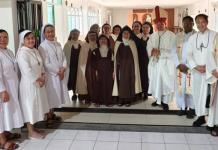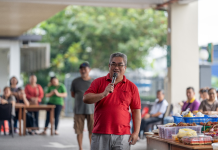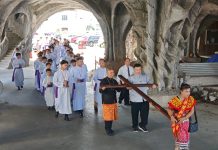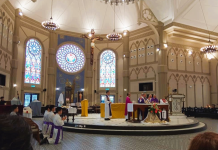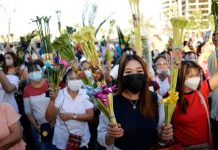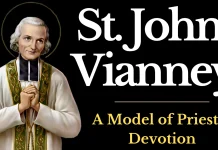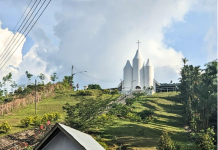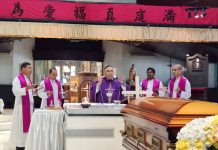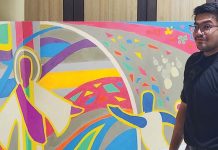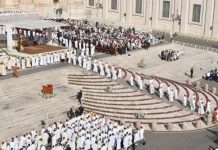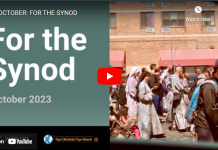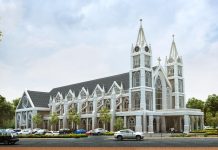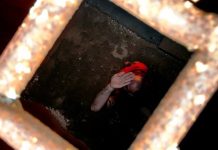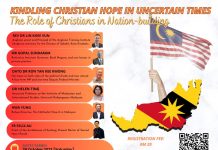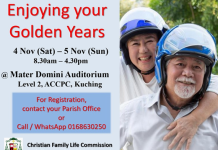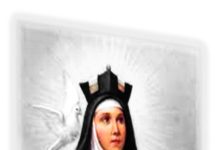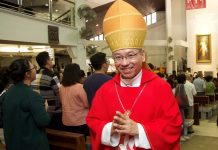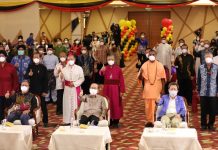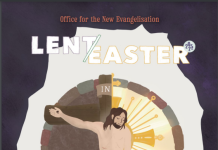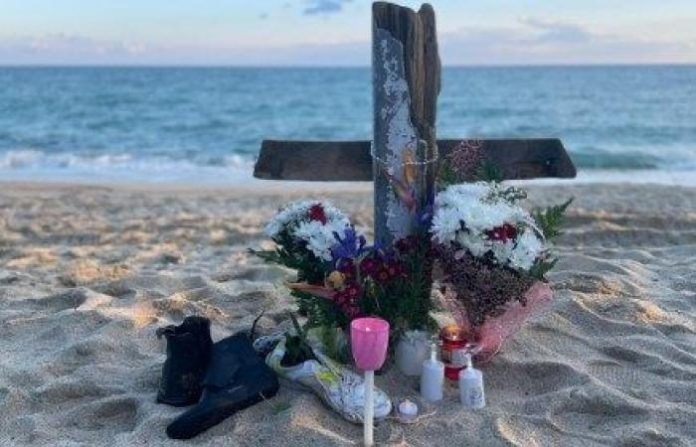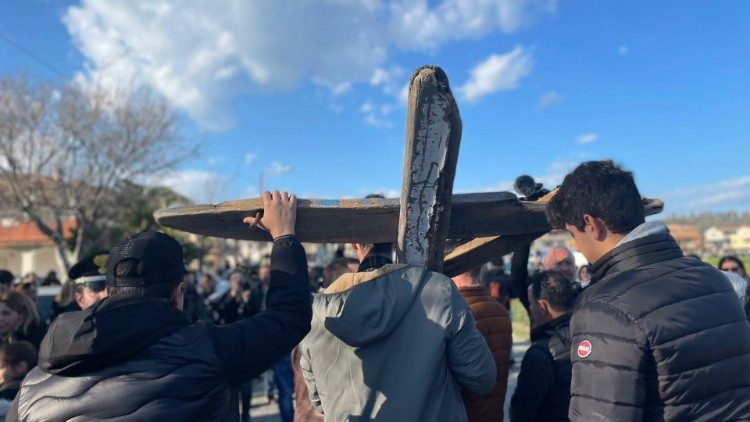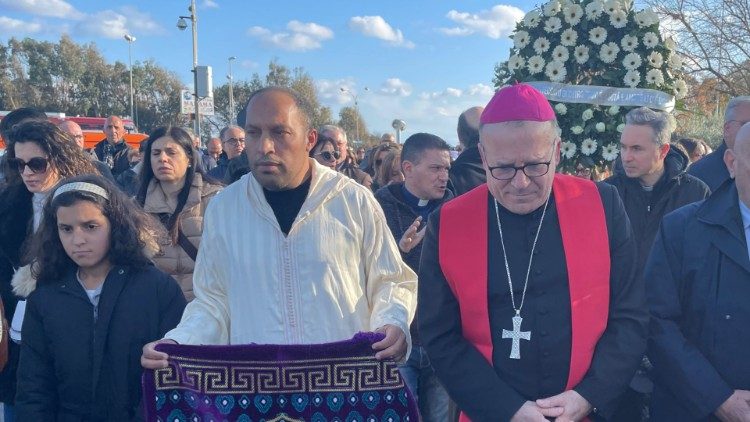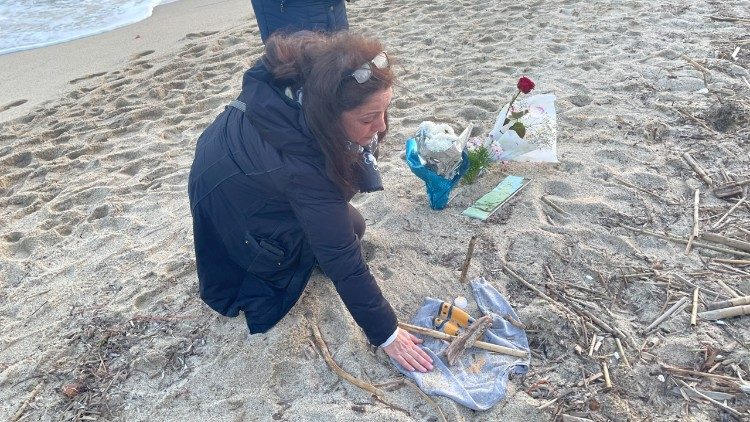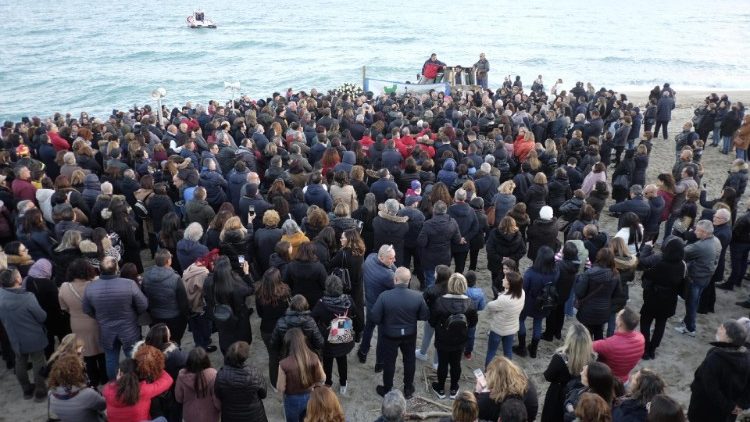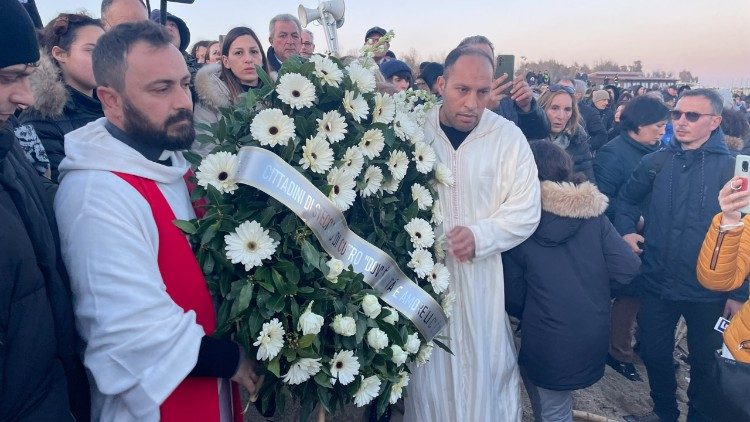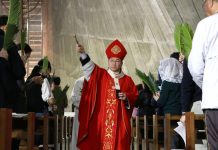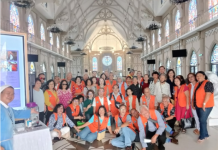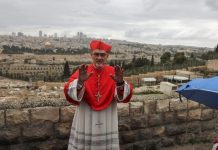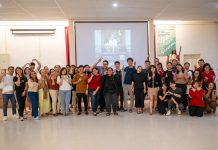Some five thousand people participate in the Stations of the Cross on Sunday at the site of the migrant tragedy in southern Italy. Leading the ceremony were an archbishop and an imam who called for a welcoming and inclusive Europe. To date, 70 bodies have been recovered, at least 27 – probably many more are still missing – and 80 people have survived.
By Salvatore Cernuzio
CUTRO, ITALY — A tiny grey sweatshirt lies on the beach at Steccato di Cutro, it is partially covered with sand, pebbles and debris washed up from the sea. Someone has crafted a small altar beside it, with candles, flowers and a cross.
The tragic memento marks one of the 14 Stations of the Cross organized by the Archdiocese of Crotone-Santa Severina to commemorate the scores of migrants who found death in the waters of the Ionian Sea at dawn on Sunday 26 February, when their boat, that had set sail from Turkey, hit a shoal, breaking into a million pieces, throwing men, women and children into the water.
As he did on Sunday 26 February, the day of the tragedy on the coast of Italy’s southern Calabria region, a week later Pope Francis at the Angelus again expressed his sorrow:
“May human traffickers be stopped, and may they not continue to throw away the lives of so many innocent people!”
Cross made with the wood of the sunken vessel
On that shore where the bodies of 71 migrants – most of them Afghans and Pakistanis – have been returned from the water, stripped bare by the violence of the waves, the people of Crotone and the surrounding area walk in procession behind an enormous lopsided wooden crucifix. It’s made from the wood of the shattered barge, joined by the same bolts and nails that held the vessel together.
The crucifix was made by a local carpenter just hours after the tragedy and it will be kept in the parish of Le Castella. Parish priest Don Francesco Loprete says it reminds him of the cross of Jesus: “This rough, cold wood bears the body of so many innocent people who died for the sins they did not commit, it symbolizes the dreams of our brothers and sisters.” As the days go by, Don Francesco adds, “The sea is taking everything away.”
“The risk is that we too will erase from our minds this tragedy that has touched us so deeply.”
Parishioners and mayors carry the crucifix
The faithful from the parishes of Botricello, Rocca Bernarda, Belcastro, Le Castella, Isola Capo Rizzuto, San Leonardo and all the neighbouring municipalities take turns to carry the cross on their shoulders during the procession. The lifeless bodies of some of the migrants have washed up the beaches of some of these villages in recent hours. The mayors shouldered the cross for the penultimate station.
The Archbishop and the Imam
Behind the Mayors, in the shadow of the cross’ wooden arms, Archbishop Angelo Raffaele Panzetta and the Imam of the Mosque in Cutro, Mustafa Achik, walk side-by-side praying together for the souls of the victims, most of whom are of Islamic faith. With his red stole, the bishop has his hands joined in prayer; the imam, flanked by his 14-year-old daughter Malak, holds the rug used by Muslims for their five daily prayers.
It’s a powerful image, like when the two kneeled together before the 66 bodies lined up on 1 March as they lay in state in the only structure in Cruto large enough to host them. As soon as Bishop Panzetta arrived on the beach, after kissing the cross and blessing those present, he immediately announced that the Stations of the Cross was being held “in union with our Muslim brothers and sisters, to pray together to the one God”.
Deep-felt participation
Participation was enormous and unexpected. The “Migrantes” Office said thousands of silent citizens felt it was their duty to be present. A woman who had come to pay tribute to the victims with her husband said she felt “personally involved in this tragedy that has knocked at our doors.” The crowd making its way on the sand is made up of people from all walks of life: firemen, sports groups, local shopkeepers, children, the elderly, entire families, two boys in wheelchairs, the archbishop of Cosenza, Giovanni Checchinato, and the bishop of Lamezia Terme, Serafino Parisi.
Songs and prayers
They wept, and they sang songs of praise to Jesus: “How can I be shipwrecked if you are at the helm…”, they prayed as they followed the indications of the parish priest of Botricello, Don Rosario Morrone, who was among the first to reach the shore when the tragedy happened. During the Way of the Cross that commemorates Christ’s journey to Mount Calvary on the day of the crucifixion, prayers are said for innocent children who die from injustice, for those who suffer due to the tragedies of the world or because of ‘exclusive and selfish policies’, for mothers who lose their children.
Tears on the sand
The sky, at first clear, darkens as the crowd arrives, almost as if to contribute to the sorrowful atmosphere before the remains of the shipwreck. Mismatched shoes, clothing, lifebuoys, toys, and food supplies. The undertow has washed everything ashore. Relatives of the victims, locals and even the survivors themselves who have visited what has been dubbed the ‘beach of sorrow’ in recent days, have gathered these sad items and arranged them under improvised crosses made of wood and wire. On one of these crosses, an elderly woman kneels and lays a red rosary. She makes the sign of the cross, then joins the crowd that reaches as far as the surrounding hillsides, to listen to the archbishop’s closing words beside the wreckage.
‘We want to be hospitable communities’
“Jesus is the open and welcoming heart of God towards humanity. As we walked together, we asked ourselves: ‘are we still Christians? Sure, we have Christian roots, works of art, the crucifix on a chain around our necks, we do our novenas, we baptise our children. But how is it that after 2000 years of walking behind Jesus we have not really learnt to welcome each other? There is something wrong in our lives…,” Bishop Panzetta says.
“If we truly welcome Jesus,” he continues, “we must allow our hearts to be changed and not allow fear to make us cold-hearted.”
“If we are Christians, we cannot not be welcoming, we must have an open heart like Jesus and therefore we do not want a Europe closed in by barbed wire, a Europe in which it is difficult to find a welcome.”
“The poor are the body of Christ, those who have lost their lives in this sea are the flesh of Jesus. And so, looking at this very sea, we must all repent, no one excluded. Because we have the responsibility to generate and fuel a climate of welcome, fraternity, friendship.”
“Let us ask the Lord for this gift of conversion: we want to be hospitable communities,” the bishop concludes saying “It’s in the DNA of our people, of our territory, to have a wide-open heart.”
“Let us not allow fear to make us cold-hearted communities, terrified in the face of diversity. We want a conviviality of differences.”
The wreath in the sea, as in Lampedusa
The Eternal Rest Prayer concludes the Stations of the Cross. The Imam thanks everyone for the support shown to the Islamic community. Together with a priest he throws a wreath of white flowers into the sea. This gesture takes everyone’s memory back ten years, to Lampedusa, when Pope Francis made the same symbolic gesture to honour the memory of the dead, buried not in the earth, but in the waters of the Mediterranean, “an open-air graveyard”. Even more so, after this umpteenth tragedy.

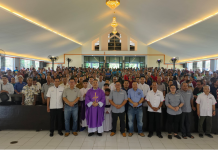
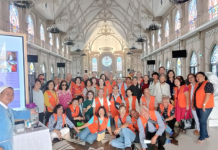
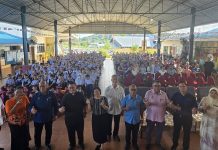
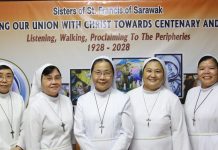
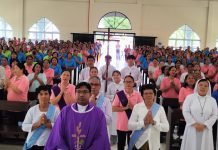
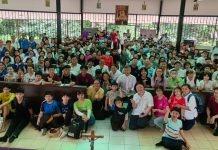

、尤金·玛格拉桑神父(Fr-Eugene-Maglasang)(前排右八)及叶祥胜神父(前排右十)于2025年1月25日在圣体堂合影。(摄影:蔡彼得).jpg)
